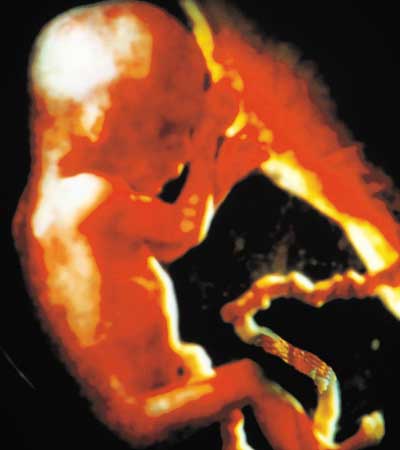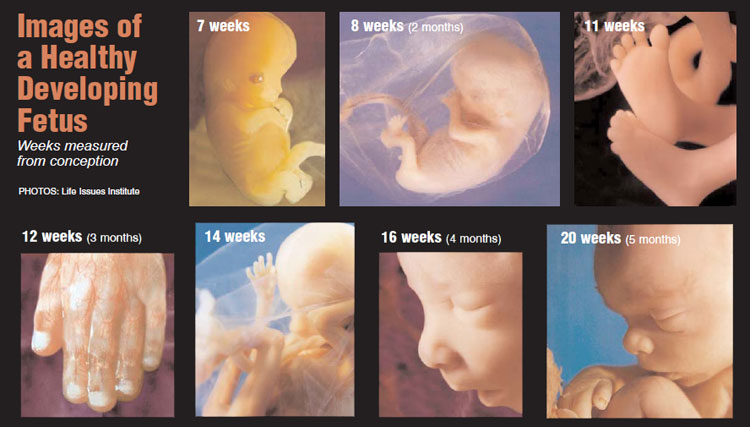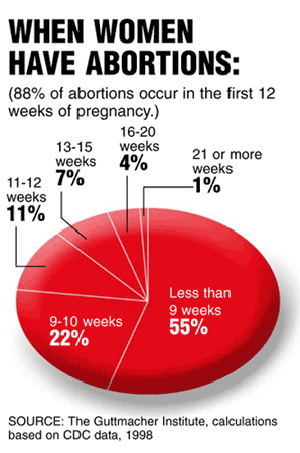Part 1 ABORTION: Woman's Choice or Modern Holocaust?
Next Part The Procedure
Back to By David C. Pack
Part 1 ABORTION
Since its legalization in 1973, nearly 50 million abortions have been carried out in the United States alone. Is abortion simply “a woman exercising her rights over her body”? Or something much more grave?
Thirty years after the Roe versus Wade case, which led to the legalization of abortion in the United States, the battle still rages on. Those on both sides of this issue, firmly entrenched in what they believe to be morally and ethically right, are taking their campaigns to the street, television studios, abortion clinics and, chiefly, Washington, D.C.
Part 2 ABORTION: Woman’s Choice or Modern Holocaust?
Some resort to political mudslinging to get their point across. Others to violence, murdering those they feel are guilty of the same crime! Adding to this chaos, developments in stem-cell research and the Laci Peterson murder case are causing some activists to lose sight of their political stance.
What confusion! Little did the Supreme Court imagine that their ruling would lead to such a divisive battle in the United States.
On the PRO-LIFE side (sometimes referred to as “anti-choice”), abortion is seen as the outright slaughter of innocent lives, as merely a convenient way for women to “resolve the problem” of unplanned and unwanted pregnancies. By promoting abstinence in sex education programs, instead of merely the use of contraceptives, pro-life supporters reason that there would be fewer unwanted pregnancies. In addition, they suggest that any unwanted children could be adopted by one of the thousands of couples unable to have children.
In the wake of the murder of Laci Peterson and her eight-month-old unborn son, Conner, momentum is now building to make it a federal crime to harm a fetus. The Unborn Victims of Vi*olence Act, now dubbed “Laci and Conner’s Law,” seeks to treat a fetus as a separate victim. Under the law, anyone who harms a fetus would spend as much time in jail as if the mother were harmed. Additionally, handing abortion opponents their greatest victory in decades, Congress banned the procedure known as “partial-birth abortion” in June 2003. These developments are causing pro-life supporters to wonder whether the Bush administration is taking the much-anticipated steps to overturning Roe v. Wade.
On the PRO-CHOICE side (sometimes referred to as “anti-life”), advocates view abortion as a way of putting children who may be born with birth defects or diseases out of their misery. This allows the medical community to terminate fetuses that would otherwise have short lives and long, painful deaths caused by genetic disorders or other such maladies. Abortion is also seen as a way of reducing the number of unwanted children who would be born into abusive or poverty-stricken homes, thus reducing child abuse. Pro-choice supporters also state that if a woman happens to be a victim of rape or incest, she should have the option of abortion readily available.
Overall, the pro-choice movement states that a woman should have the right to choose whether to keep or abort the child growing inside her body. In effect, the reasoning is, “It’s my body, so I decide what to do!”
Therefore, the struggle continues, with many millions of unborn children caught in between. Whether single or married, parent or child, young or old, and regardless of race or religion, abortion has affected us all—in more ways than most realize.
“Abortion on Demand”
Over thirty years ago, the Supreme Court handed down a decision that legalized abortion in the U.S. Before this time, abortion was illegal and simply considered an IMMORAL action that one would never think of actually debating.
This soon changed. Although Texas law prohibited abortion, except to save a pregnant mother’s life, Jane Roe, a resident of the state, filed a lawsuit seeking to obtain one. The court ruled that a woman had a constitutionally protected right to have the procedure, and that this fell within the right to privacy, as protected by the Fourteenth Amendment. The decision made it legal for a woman to have an abortion at any point during the pregnancy. It also defined levels for regulating abortion in the third trimester of the pregnancy—weeks 27 through 40.
In effect, the final verdict ruled that a child is the property of the parent—who has the right to decide whether the child is wanted.
Attempting to walk the tightrope allowed by the U.S. Constitution, Justice Harry Blackmun stated, “The Constitution does not define ‘person’ in so many words. Section 1 of the Fourteenth Amendment contains three references to ‘person.’ The first, in defining ‘citizens,’ speaks of ‘persons born or naturalized in the United States’…But in nearly all these instances, the use of the word is such that it has application only postnatally. None indicates, with any assurance, that it has any possible pre-natal application…
“We need not resolve the difficult question of when life begins. When those trained in the respective disciplines of medicine, philosophy, and theology are unable to arrive at any consensus, the judiciary, at this point in the development of man’s knowledge, is not in a position to speculate as to the answer” (emphasis ours throughout).
As a result, this court ruling affected the laws of all 50 states.
Liberals and the feminist movement at the time viewed this as a monumental step in the “emancipation” of women—of leveling the playing field with men, who never had to deal with an unwanted pregnancy. Women now had the right to CHOOSE—a family or a career, marriage and a monogamous relationship with a husband ora single life of sexual freedom. Additionally, since unwanted children could now be aborted, child abuse would soon end.
But since then, what has happened to this “brave new world” of women’s liberation and freedom—one supposedly free of child abuse?
Not exactly what was envisioned. In fact, aside from a high increase in sexual promiscuity, sexually transmitted diseases and AIDS, child abuse has skyrocketed since 1973, when 167,000 cases were reported in the U.S. In 1980, the number rose to 785,100; in 1987, there were 2,025,200 cases; in 1989, there were 2,435,000; and in 1999, there were 3,244,000 cases of reported child abuse (National Center on Child Abuse Prevention Research). These numbers speak for themselves. Clearly, this is not the result foreseen by feminists and liberals in the 1970s.
Sobering Statistics
Since 1973, has the “better, brighter tomorrow” envisioned by the feminist movement become reality? What has been the result of Roe v. Wade? To what extent have women in the U.S. sought abortions? The facts are staggering:
• Abortion is one of the most common surgical procedures.
• The estimated number of legal abortions performed in America alone since 1973 is nearly 50 million—and this is said to be even greater, since it only represents abortions reported by licensed agencies.
• Every twenty-two seconds, an abortion takes place in the U.S.
• According to the Department of Defence, the total American casualties for the Revolutionary War, War of 1812, Mexican War, Civil War, Spanish-American War, World Wars I and II, Korean War, Vietnam War, Gulf War and the Iraq War, in addition to deaths attributed to September 11—all combined—is estimated at 1.27 million. In 2001, 1.31 million pregnancies in the U.S. alone ended in abortion—down from the all-time high of 1.61 million in 1990.
• At least one in three women in the U.S. will have had an abortion by age 45.
• By age 20, one in seven women in the U.S. will have had an abortion.
• About 19% of women having abortions in the U.S. are teenagers; 33% are age 20-24; 48% are age 25 and older. • About 83% of abortion patients are unmarried.
• 26% of women seeking abortions have the procedure billed directly to their public or private insurance.
• The Alan Guttmacher Institute stated that the worldwide abortion rate (the number of abortions per 1,000 women age 15-44) can range from a low of 6.5 in the Netherlands, to a high of 77.7 in Cuba.
The U.S. abortion rate is 21.3, comparable to other developed nations such as Sweden (18.7) and Australia (22.2).
• Black women are more than 3 times as likely as white women to have an abortion, and Hispanic women are 2½ times as likely.
• About 43% of women obtaining abortions identify themselves as Protestant, and 27% identify themselves as Catholic.
• Over 60% of abortions are among women who have had 1 or more children.
The following is an overview of the growth process, from a fertilized egg to a cuddly newborn baby, illustrating the amazing transformation of what some term “fetal tissue.”
The First Trimester (weeks 1 through 13): Fertilization, or conception, takes place when the chromosomes of the sperm and the egg combine. Conception is calculated as occurring two weeks after the woman’s last period. (This is the date from which the weeks of pregnancy are determined.) Within the next week, the fertilized egg will bury itself in the lining of the uterus, where it can be protected and nourished throughout its growth.
This begins the development of the embryo’s physical characteristics, such as the backbone, spinal column, nervous system, kidneys, liver and intestines. By week three, the heart begins beating. At five weeks, the brain begins developing. In the seventh week, facial features, including the eyes, mouth and tongue, begin to be visible on the small, raisin-sized embryo. Blood cells develop, giving the unborn child its own blood type. The muscle system also begins development, allowing movement within the womb.
Also in week seven, brain waves can be measured. (Ironically, brain waves are one of the legal criteria in determining whether a person is alive. So, if one can be pronounced “dead” because there are no measurable brain waves, then how can one not be considered “alive” when brain waves are detected?)
Arms, legs and toes are growing, and the placenta can now provide oxygen for the baby to “breathe.” Blood is redirected through the almost completely formed heart. In week ten, teeth begin to bud in the unborn child’s mouth. Week twelve brings the production of vocal cords, and crying in the womb becomes possible, although quieted by the amniotic fluid. Because of the now fully developed brain and nervous system, the child can feel pain. Eyelids are formed, protecting the optical nerves until the eyes are opened in the seventh month. Also during this point, the unborn baby can often be seen through ultrasound sucking its thumb.
Over 88% of abortions take place within this first trimester of a pregnancy!
The Second Trimester (weeks 14 through 26): With the baby’s developing muscle system and growing arms and legs, the mother begins feeling kicks and movement. During weeks fifteen and sixteen, eyebrows, eyelashes, hair and taste buds appear. With fully developed hands and feet, the baby can now kick, grab and grasp.
By weeks sixteen through twenty, a doctor can determine the sex of the child through an ultrasound. The unborn baby now has fingernails, fully developed fingerprints, and can even recognize its mother’s voice. By this point of the pregnancy, the fetus, while not yet fully developed, could survive outside the womb.
About 11% of abortions take place within this second trimester of the gestation process. The Third Trimester (week 27 through birth): The fetus is now completely formed and only needs time for growth and the maturing of internal organs. Legs are now proportionate to the entire body, and toenails, teeth, hair and eyebrows are now visible. A thin hair, called laguno, covers much of the baby’s body at six months, and a waxy covering, vernix, coats the skin. The baby breathes oxygen-rich amniotic fluid into its developing lungs. Most of the baby’s time will be spent sleeping during the seventh and eighth months. The baby also begins to experience REM (rapid eye movement) sleep, which causes dreams. For several months, the baby has been feeding through the umbilical cord, drawing nutrients from the mother’s blood. Now that the baby is tightly confined to a small space within the uterus, the mother feels numerous squirms and wriggles. It is only a few weeks until the baby is born.
One percent of abortions take place within the third trimester of the pregnancy. While abortion advocates state that 1% is insignificant, keep in mind that it is 1% of an estimated 1.5 million abortions a year. What seems to be a small number is actually an estimated 15,000 third-trimester abortions a year—or 1,250 a month—about 40 a day! When seen in the proper context, this 1% is far larger than most care to admit.
Next Part The Procedure
Back to By David C. Pack




